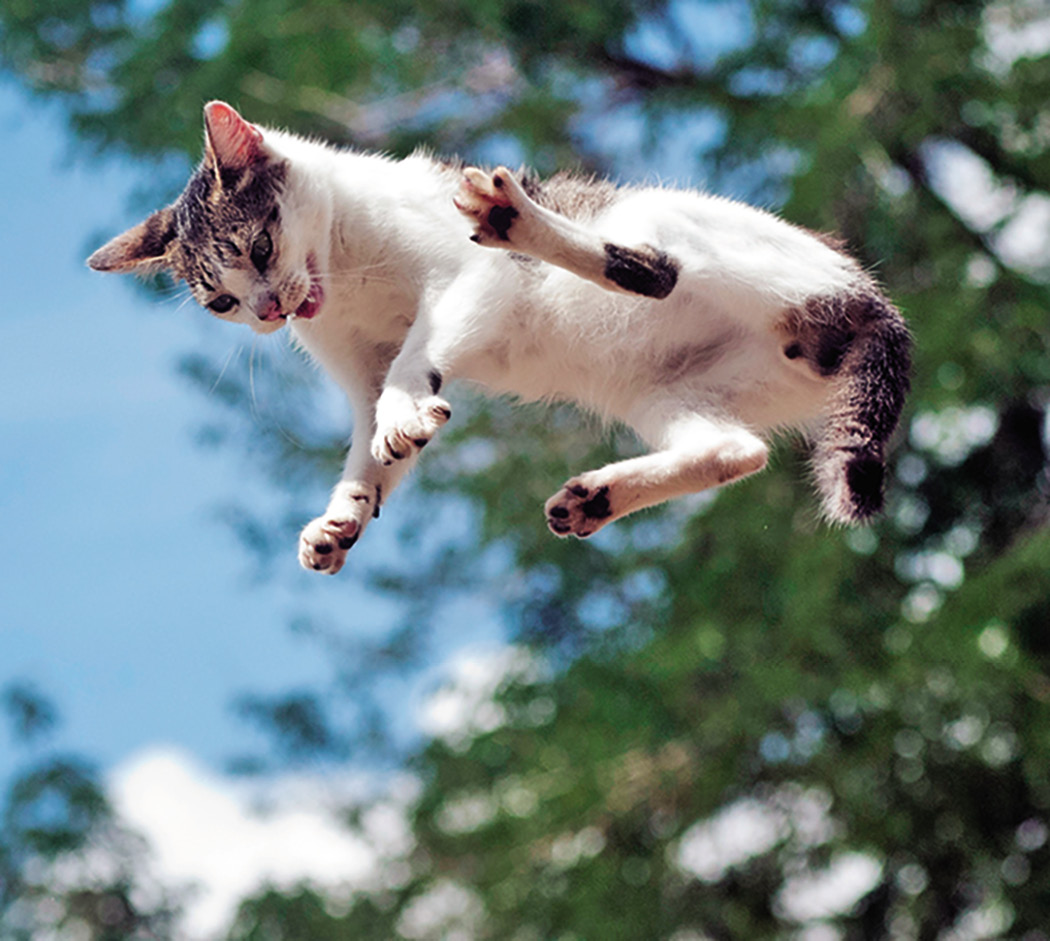Cats are well-known for their ability to land on their feet almost all the time. This talent has fascinated people for centuries, and as buildings get taller, cats’ ability to survive falls from extreme heights has perplexed many.
The secret? A cat’s small size, flexible spine, incredible vestibular system, and a little bit of luck.
Balancing Act
All normal healthy cats have a natural sense of where their body parts are in relation to the ground. This is called proprioception, and almost all mammals have it. For example, if you pick up one of your cat’s paws and place it so the top of the paw is touching the ground, she will immediately place it correctly with the pads touching the ground without “thinking” about it.
Proprioception also plays a role in cats’ ability to jump, climb, and balance. Nerves throughout the limbs and body work together along with sensory whiskers (including ones on the back of her front legs) to tell your cat exactly where her feet are in relation to obstacles, such as tree branches, the back of the couch, or a thin porch railing.
Cats have been selected for these skills over generations because the ability to jump and balance effortlessly increases their success as hunters and to evade predators, especially when climbing trees.
The Twist
In 1894, French physiologist Étienne-Jules Marey took an incredible series of photos capturing a falling cat. The cat starts with its feet pointing upward, then twists around to land on its feet. The series was published in Nature.
The May 1916 issue of The American Journal of Physiology included an analysis of how cats maneuver their bodies in the air to land gracefully. Researchers from Johns Hopkins University noted this same phenomenon: When a cat falls, she quickly rotates her body to orient herself correctly. If you drop your cat while carrying her, she will adjust her body based on how she knew she was positioned originally and where she “should” be. This allows her to land on her feet most of the time.
High-Rise Syndrome
But if a cat landing on her feet after being dropped by her owner doesn’t impress you, cats have fallen from much higher heights and survived. Veterinarians call the injuries sustained by a cat in a fall from these heights “high-rise syndrome.”
In 1987, the Journal of the American Veterinary Medical Association published a study that looked at the medical records of 132 cats who fell out of high-rise windows in New York City and were brought to the Animal Medical Center. Many of the cats had serious injuries, but 90% of them survived despite an average fall of 5.5 stories.
Even stranger, the severity of injuries did not have a direct relation to the height of the fall. Cats who fell from up to seven stories were progressively more likely to be severely injured, but over seven stories, they did better. One cat even survived a fall from a 46-story building.
One thing to keep in mind with this study is that it only looked at cats who were brought to the veterinary hospital. Cats who died on impact likely were not brought in and, therefore, are not included in the statistics.
In 2004, the Journal of Feline Medicine and Surgery published a study that reviewed 119 cats that fell from buildings in Zagreb, Croatia, and were brought in for evaluation. The average height of the fall for these cats was four stories, and 96.5% of the cats survived, which is close to the results from the previous study. The 2004 study observed that cats had more severe injuries as the height of the fall increased, but two other studies have observed similar results to the 1987 study. Once again, only cats who were brought to the veterinary hospital were included in the statistics.
It’s Physics
While high-rise syndrome cats often do have injuries, ranging from fractures to punctured lungs, they do survive more often than it seems like they should. This may be because along with their incredible body awareness, they are also small and reach terminal velocity—maximum speed when falling—much more quickly than, for example, humans.
Cats have a terminal velocity of about 60 miles per hour (mph), while an adult human male has a terminal velocity of about 120 mph. In 2017, at the British Small Animal Veterinary Association conference, British veterinarian Alex Lynch noted that cats reach this speed at about five stories.
Why is this important? Before the cat reaches terminal velocity, she feels that she is accelerating and her limbs are extended out stiffly, braced for impact.
Once she hits terminal velocity, the cat relaxes her limbs and spreads them out like a flying squirrel. This position makes the cat’s landing less jarring and spreads the force of impact over more of her body.
For the cats falling from higher than five stories, they likely have enough time to orient and reposition themselves and to reach terminal velocity and relax. All these factors combine to help the cat land upright and suffer less serious injuries than other animals experiencing the same fall.




